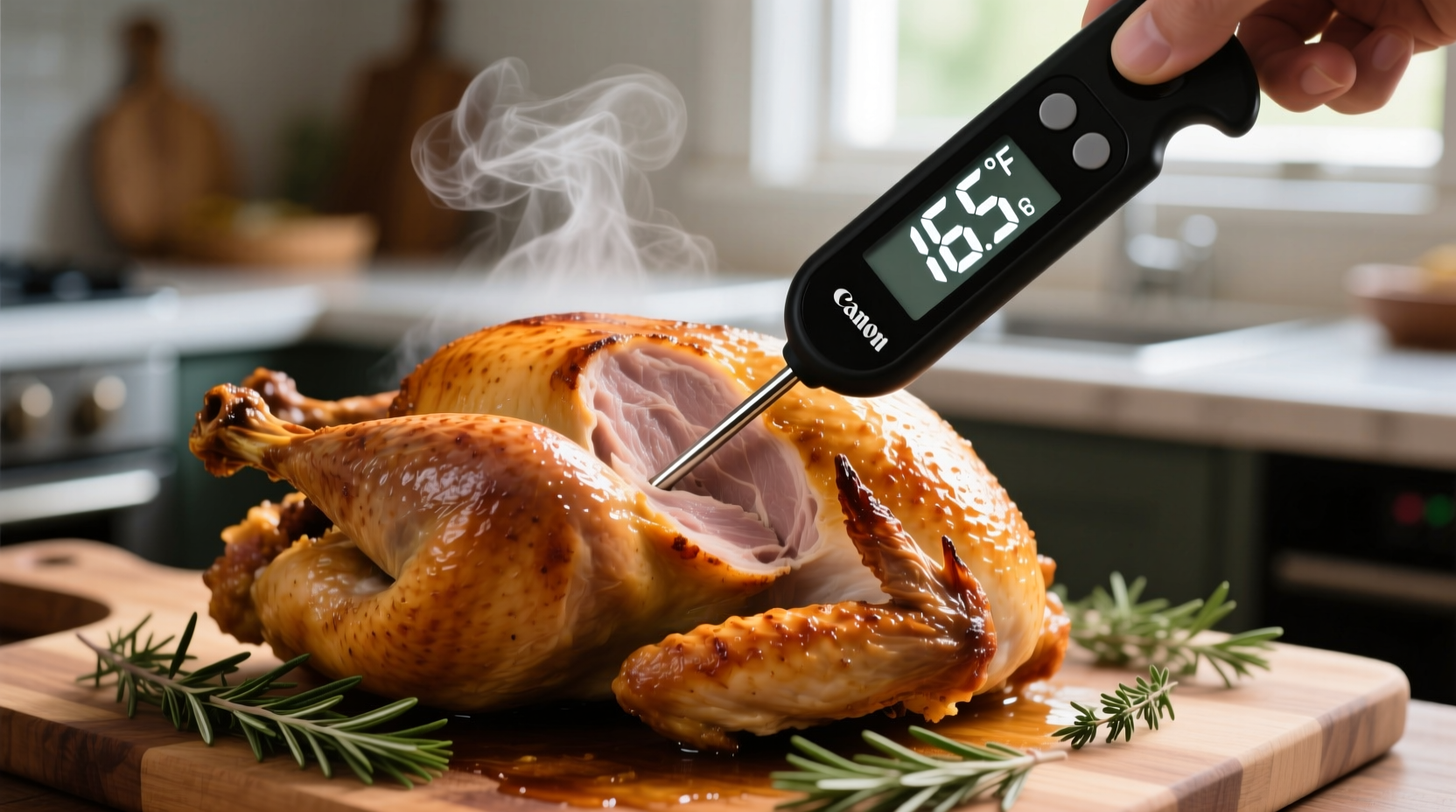The safe internal temperature for cooked turkey is 165°F (74°C) as measured with a food thermometer in the thickest parts of the breast, thigh, and wing. This USDA-approved temperature ensures harmful bacteria like salmonella are eliminated while maintaining optimal moisture.
Why Temperature Matters More Than Cooking Time
While many recipes focus on "X minutes per pound," the only reliable method to determine if your turkey is safely cooked is by checking its internal temperature. Cooking times vary significantly based on oven accuracy, turkey size, whether it's stuffed, and even room temperature. Relying solely on time can lead to undercooked poultry (risking foodborne illness) or overcooked, dry meat.
The Science Behind 165°F: Food Safety Explained
According to the USDA Food Safety and Inspection Service, poultry must reach 165°F to destroy harmful pathogens like salmonella and campylobacter. At this temperature, bacteria are eliminated in seconds:
| Temperature | Bacteria Elimination Time |
|---|---|
| 160°F (71°C) | 20 seconds |
| 165°F (74°C) | Instant |
| 150°F (66°C) | 2.8 minutes |
This data from USDA's Food Safety Education materials confirms why 165°F is the critical threshold for immediate pathogen destruction.

Proper Temperature Checking Technique
Where and how you check temperature matters as much as the number itself:
- Multiple locations: Check the innermost part of the thigh, wing, and thickest part of the breast
- Avoid bones: Insert thermometer into meaty areas, not touching bone
- Wait 10 seconds: Allow thermometer reading to stabilize
- Cross-check: Verify readings in at least three different spots
For stuffed turkeys, the stuffing center must also reach 165°F. Many food safety experts recommend cooking stuffing separately to ensure proper temperature without overcooking the bird.
Temperature Timeline for Perfect Turkey
Understanding how turkey temperature changes during cooking helps prevent mistakes:
- Preheat phase: Oven reaches 325-350°F (standard roasting temperature)
- Initial cooking: Turkey slowly warms from refrigerator temperature (40°F) to 130°F
- Danger zone crossing: Critical period between 40-140°F where bacteria multiply rapidly
- Final push: Temperature rises from 150°F to 165°F (this takes longer than expected)
- Resting period: Temperature continues rising 5-10°F after removal from oven
Common Temperature Mistakes and How to Avoid Them
Even experienced cooks make these temperature-related errors:
- Trusting pop-up timers: These often trigger at 160-165°F but can activate prematurely
- Checking too early: Opening the oven frequently drops temperature and extends cooking time
- Ignoring carryover cooking: Removing turkey at exactly 165°F results in overcooking
- Misplaced thermometer: Checking near bones or in thin areas gives false readings
Professional chefs recommend removing turkey when it reaches 155-160°F in the breast, then letting carryover cooking during resting complete the process to 165°F.
Resting Time: The Critical Final Step
After reaching target temperature, let your turkey rest for 20-40 minutes (depending on size) before carving. During this time:
- Temperature equalizes throughout the bird
- Juices redistribute, preventing dry meat
- Final cooking continues (carryover effect)
- Meat fibers relax for easier carving
Cover loosely with foil to retain heat without creating steam that would soften the skin. Never skip this step—even if guests are waiting.
Special Considerations for Different Cooking Methods
While 165°F remains the universal safety standard, cooking methods affect temperature management:
- Deep frying: Requires precise oil temperature (350°F) but internal turkey still needs 165°F
- Smoking
- Spatchcocking: Flattened birds cook faster but still require 165°F in all parts
- Sous vide: Can cook at lower temperatures (145-150°F) for extended periods, but standard roasting requires 165°F
The USDA maintains that for conventional oven roasting—the most common home method—165°F remains the necessary internal temperature regardless of cooking technique.
When to Trust Your Thermometer Over Visual Cues
Many home cooks rely on visual indicators like clear juices or golden skin, but these are unreliable:
- Juices can run clear at temperatures as low as 140°F—still unsafe
- Skin color depends on oven temperature, not internal doneness
- Legs moving easily indicates tenderness but not safety
A 2023 survey by the Food Safety and Inspection Service found that 38% of home cooks don't use thermometers for poultry, contributing to preventable foodborne illness cases. Always prioritize thermometer readings over visual cues.
Recommended Thermometer Types
Not all thermometers provide equally reliable readings:
- Digital instant-read: Most accurate for spot-checking (recommended by FDA)
- Oven-safe dial: Less precise but convenient for monitoring during cooking
- Leave-in probe: Ideal for large birds, provides continuous monitoring
- Disposable pop-up: Least reliable—use as backup only
Calibrate your thermometer regularly by testing in ice water (should read 32°F) or boiling water (212°F at sea level).
Food Safety Beyond Temperature
Temperature is critical but not the only food safety factor:
- Thaw turkey properly in refrigerator (never at room temperature)
- Wash hands and surfaces after handling raw poultry
- Don't rinse turkey before cooking (spreads bacteria)
- Refrigerate leftovers within 2 hours
Following these practices alongside proper temperature control creates multiple safety barriers against foodborne illness.











 浙公网安备
33010002000092号
浙公网安备
33010002000092号 浙B2-20120091-4
浙B2-20120091-4